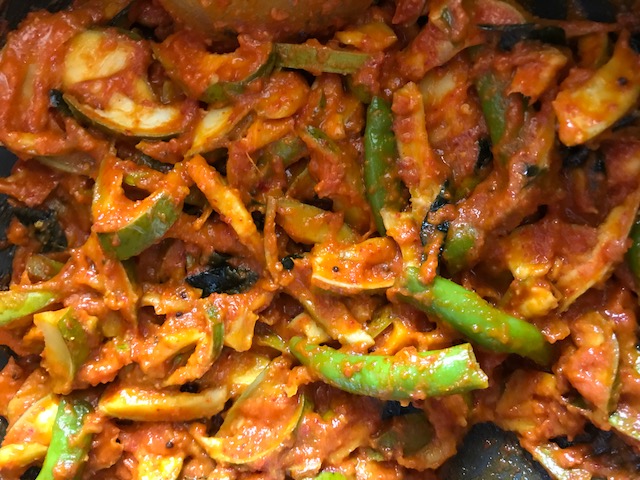Although I live in California, the Tashi Lhunpo monastery, in South India, is a place where I sometimes go for extended visits, and I have written about my experiences there.
Mango trees around the monastery are loaded with mangos. Some are picked clean while the fruit is still very green. One day, while I went to the local market, I saw baskets filled with large green mangos for sale. They looked like a variety sold in Thailand, the country where I was raised. Though still not ripe, they were sweet and crunchy. Curious, I asked Ani Choeling, who is a nun at the monastery, and was told that the ones for sale were very sour and that people bought them to make mango pickles. It gave me an idea of trying to make my own.
Back at the monastery, I picked up a couple of little ones that had fallen on the ground under a tree that had been raided by monks earlier, with the choice ones taken. The next day, I found a big green one that had been left on top of the cement wall near the walkway to my room. I picked it up too. I asked Ngawang, a monastery office worker who speaks the native language, Karnataka, to ask the Indian ladies who take care of the garden if they would teach me how to make pickled mango. Apparently, several years ago, while the new temple was being built, one particular lady from the north had harvested mangos and made jars of mango pickle. This could have been a southern version or the lady’s own from her home region.
In this small village, women still cook in the traditional way, learning how to cook using recipes passed down from family members. Pickles, like other recipes, have many variations with a touch of theirs, family or friends. Cooking, in this part of the world, is still a part of normal family life and tradition.
I was not sure if Ngawang ever followed through with my request, as I’d had no response to it. An idea came to me that I could try to communicate on my own by finding a picture of mango pickle on my cell phone and showing it to the ladies. Sure enough, all four ladies, when they saw the picture, smiled and said in unison, “mango pickle.” One of them took the large mango from my hand, sniffed it, smiled, and shook her head side to back approvingly.
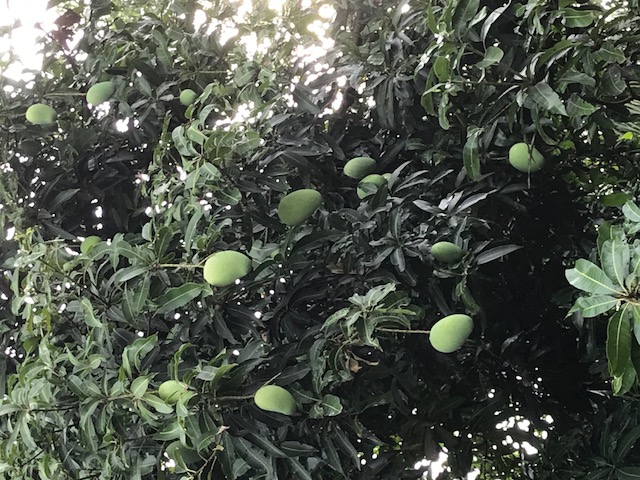
I pointed to a tree outside the garden loaded with large green mangos. They, in turn, pointed to several trees in the garden that I’d never noticed before, also loaded with mangos. They then spoke and pantomimed about cutting and drying the mangos in the sun.
I had read several recipes for mango pickle online and assumed that they would need a knife and salt to dry them. I went back to my kitchen and brought out a tray, a small jar of salt, and a knife. In late afternoon, as they were leaving for home, one of them brought back the tray filled with shriveled mango cut into long, bite-sized strips. The exterior of each strip was dry, but when I touched one the inner flesh gave in a bit. The sundried mango exuded its scent of sweet, sun-ripe mango. The lady also brought back the clean knife and my jar of salt. From what was left in the jar, it looked like they had used no more than 30 ml (2 tablespoons) of salt.
The next morning, I saw the same four ladies walking to the garden to work. I asked in English if they would come to make the mango pickle. They seemed to understand and nodded, but went on walking to work. I waited for a while but no one came.
A couple of hours later, two of the Indian ladies showed up at my door, smiling and gesturing toward the kitchen. They’d brought with them a handful of curry leaves, a bag of dried bright red chilies, and fenugreek seeds.
They set to work immediately. Reading recipes had helped me figure out what they would need. One of them brought my blender over to the worktable. I wondered what they normally did at home, as they clearly loved the blender for pureeing the seasoning.
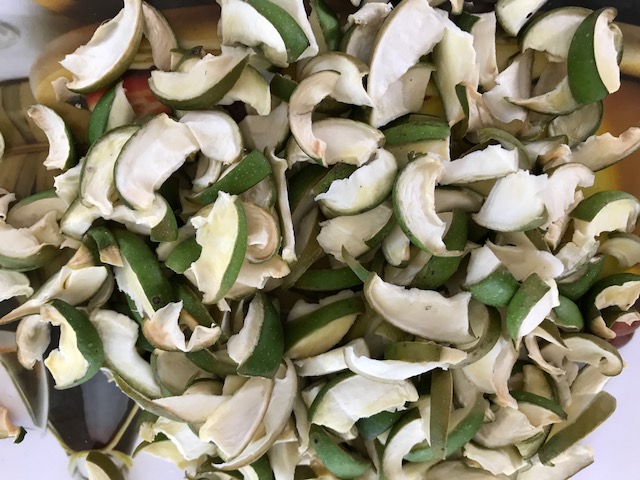
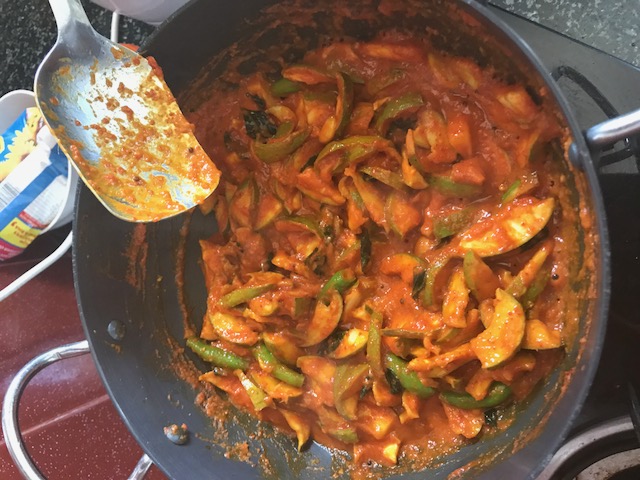

Later, after the pickle was cooked and seasoned and I sat writing while it cooled, one of the ladies showed up with 473 (2 cups) of very sour and unripe tiny gooseberries. She washed them several times and added about 237 ml (1 cup) to the mango pickle. The rest she put into a cup with water and salt and I think she told me to enjoy them. Oh, they would be very sour indeed.
Then, she scooped up the pickle into the only plastic jar I had and asked me to lace more oil over it. I believe it was another 59 ml (¼ cup). After securing the lid tightly, she told me to leave the pickle in the refrigerator for at least three days before eating them. In the meantime, what was left in the saucepan I would later mix with leftover pasta for lunch.
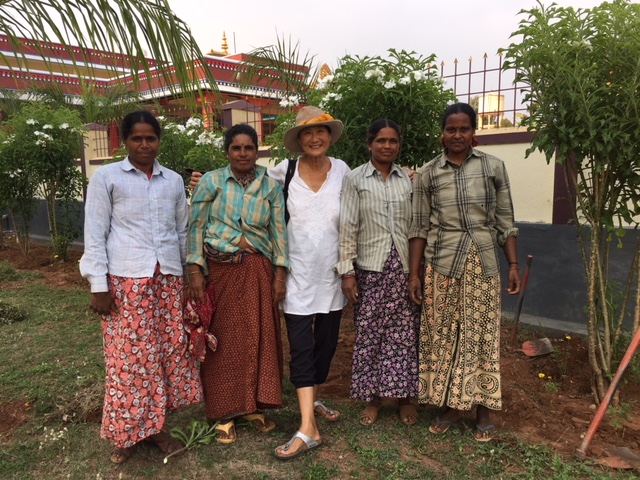
I love the ladies. Even in their work clothes, they are elegant and beautiful with an uninhibited manner. They are always ready to bid me Namaste with a hand over their heart. They spoke with me as if I could understand Karnataka. Of course, I could not and wish I could. But somehow, we were able to relate to each other, each in our own language, mostly by being open and sensitive to one another. It is the strongest and most powerful way of communication, by being mindful of our behavior and gestures with immense concentration and eye contact.
The seasoning of the pickle did not have firepower at the instant it hit my mouth, but was dominated by saltiness and sourness of the spices. It had the aroma of the spices and created a warming sensation within my chest that lingered for several minutes.
I think this same recipe would work with very unripe, hard and sour apricots or plums. The fruits must be firm to touch and very sour. I wonder if sour crab apple would work too?
After the three days passed, I began having a spoonful of pickle every day with lunch and dinner. It was “super!” as the ladies would have exclaimed. However, when I served some to Kunchok La (a young monk and head of the monastic administrative office who has become dear to me) and Ani, both told me to leave it out at room temperature and not in the refrigerator. They insisted that I had misunderstood the instructions. So, the plastic jar of mango pickle sits prettily on my dining room table. Truly, it is super! ![]()
